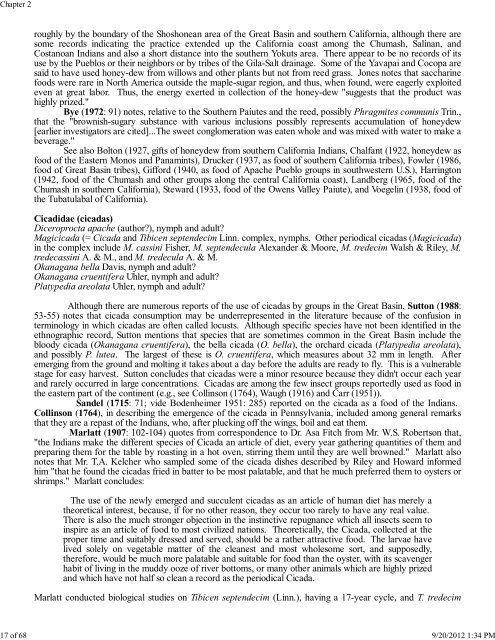Chapter 2. Insect Foods of North American Indigenous Populations ...
Chapter 2. Insect Foods of North American Indigenous Populations ...
Chapter 2. Insect Foods of North American Indigenous Populations ...
Create successful ePaper yourself
Turn your PDF publications into a flip-book with our unique Google optimized e-Paper software.
<strong>Chapter</strong> 217 <strong>of</strong> 68 9/20/2012 1:34 PMroughly by the boundary <strong>of</strong> the Shoshonean area <strong>of</strong> the Great Basin and southern California, although there aresome records indicating the practice extended up the California coast among the Chumash, Salinan, andCostanoan Indians and also a short distance into the southern Yokuts area. There appear to be no records <strong>of</strong> itsuse by the Pueblos or their neighbors or by tribes <strong>of</strong> the Gila-Salt drainage. Some <strong>of</strong> the Yavapai and Cocopa aresaid to have used honey-dew from willows and other plants but not from reed grass. Jones notes that saccharinefoods were rare in <strong>North</strong> America outside the maple-sugar region, and thus, when found, were eagerly exploitedeven at great labor. Thus, the energy exerted in collection <strong>of</strong> the honey-dew "suggests that the product washighly prized."Bye (1972: 91) notes, relative to the Southern Paiutes and the reed, possibly Phragmites communis Trin.,that the "brownish-sugary substance with various inclusions possibly represents accumulation <strong>of</strong> honeydew[earlier investigators are cited]...The sweet conglomeration was eaten whole and was mixed with water to make abeverage."See also Bolton (1927, gifts <strong>of</strong> honeydew from southern California Indians, Chalfant (1922, honeydew asfood <strong>of</strong> the Eastern Monos and Panamints), Drucker (1937, as food <strong>of</strong> southern California tribes), Fowler (1986,food <strong>of</strong> Great Basin tribes), Gifford (1940, as food <strong>of</strong> Apache Pueblo groups in southwestern U.S.), Harrington(1942, food <strong>of</strong> the Chumash and other groups along the central California coast), Landberg (1965, food <strong>of</strong> theChumash in southern California), Steward (1933, food <strong>of</strong> the Owens Valley Paiute), and Voegelin (1938, food <strong>of</strong>the Tubatulabal <strong>of</strong> California).Cicadidae (cicadas)Diceroprocta apache (author?), nymph and adult?Magicicada (= Cicada and Tibicen septendecim Linn. complex, nymphs. Other periodical cicadas (Magicicada)in the complex include M. cassini Fisher, M. septendecula Alexander & Moore, M. tredecim Walsh & Riley, M.tredecassini A. & M., and M. tredecula A. & M.Okanagana bella Davis, nymph and adult?Okanagana cruentifera Uhler, nymph and adult?Platypedia areolata Uhler, nymph and adult?Although there are numerous reports <strong>of</strong> the use <strong>of</strong> cicadas by groups in the Great Basin, Sutton (1988:53-55) notes that cicada consumption may be underrepresented in the literature because <strong>of</strong> the confusion interminology in which cicadas are <strong>of</strong>ten called locusts. Although specific species have not been identified in theethnographic record, Sutton mentions that species that are sometimes common in the Great Basin include thebloody cicada (Okanagana cruentifera), the bella cicada (O. bella), the orchard cicada (Platypedia areolata),and possibly P. lutea. The largest <strong>of</strong> these is O. cruentifera, which measures about 32 mm in length. Afteremerging from the ground and molting it takes about a day before the adults are ready to fly. This is a vulnerablestage for easy harvest. Sutton concludes that cicadas were a minor resource because they didn't occur each yearand rarely occurred in large concentrations. Cicadas are among the few insect groups reportedly used as food inthe eastern part <strong>of</strong> the continent (e.g., see Collinson (1764), Waugh (1916) and Carr (1951)).Sandel (1715: 71; vide Bodenheimer 1951: 285) reported on the cicada as a food <strong>of</strong> the Indians.Collinson (1764), in describing the emergence <strong>of</strong> the cicada in Pennsylvania, included among general remarksthat they are a repast <strong>of</strong> the Indians, who, after plucking <strong>of</strong>f the wings, boil and eat them.Marlatt (1907: 102-104) quotes from correspondence to Dr. Asa Fitch from Mr. W.S. Robertson that,"the Indians make the different species <strong>of</strong> Cicada an article <strong>of</strong> diet, every year gathering quantities <strong>of</strong> them andpreparing them for the table by roasting in a hot oven, stirring them until they are well browned." Marlatt alsonotes that Mr. T.A. Kelcher who sampled some <strong>of</strong> the cicada dishes described by Riley and Howard informedhim "that he found the cicadas fried in batter to be most palatable, and that he much preferred them to oysters orshrimps." Marlatt concludes:The use <strong>of</strong> the newly emerged and succulent cicadas as an article <strong>of</strong> human diet has merely atheoretical interest, because, if for no other reason, they occur too rarely to have any real value.There is also the much stronger objection in the instinctive repugnance which all insects seem toinspire as an article <strong>of</strong> food to most civilized nations. Theoretically, the Cicada, collected at theproper time and suitably dressed and served, should be a rather attractive food. The larvae havelived solely on vegetable matter <strong>of</strong> the cleanest and most wholesome sort, and supposedly,therefore, would be much more palatable and suitable for food than the oyster, with its scavengerhabit <strong>of</strong> living in the muddy ooze <strong>of</strong> river bottoms, or many other animals which are highly prizedand which have not half so clean a record as the periodical Cicada.Marlatt conducted biological studies on Tibicen septendecim (Linn.), having a 17-year cycle, and T. tredecim
















